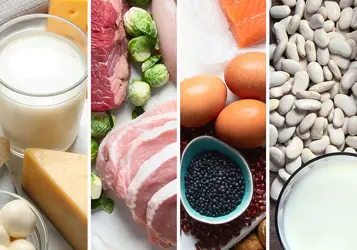In the first part of my blog series on protein synthesis measuring advances, I focused on how new techniques such as the Indicator Amino Acid Oxidation (IAAO) method are intensifying the discussion around the current recommendations for protein intake.
But protein intake goes beyond volume/quantity alone. As Prof. Paul Moughan pointed out in a previous article on The Whey and Protein Blog, quality aspects also need to be taken into consideration when talking about protein. This is why there is growing consensus on the need to shift from using a PDCAAS (Protein Digestibility Corrected Amino Acid Score) model to the FAO-recommended DIAAS (digestible indispensable amino acid score) model for protein quality measurement.
The DIAAS model draws attention to protein quality differences between the composition of animal proteins and vegetable proteins. For example, if you were to consume 90 percent of your protein from cereals, you may be taking in enough protein by quantity, but still struggling to get a high enough intake of certain essential amino acids, such as lysine. This amino acid is particularly prevalent in animal-based proteins such as milk (77 mg/g protein), eggs (72 mg/g) or beef (83 mg/g), but low in especially in cereal-based proteins like wheat (28 mg/g).
Lysine deficiency is of particular concern in women in developing countries, as their protein intake is heavily reliant on cereals, such as rice. Inadequate lysine intakes are associated with poor health outcomes, including diarrheal morbidity and decreased immune function. Parasitic infection, which is common in developing countries, also causes an increased need for lysine, further complicating this inadequate intake.
Our IAAO stable isotope-based method is adding further evidence around the higher bioavailability of animal-based foodstuffs such as whole milk over plant-based whole foods such as rice, in terms of lysine content. This type of work has implications for tackling malnutrition in developing countries.
The need for proper blending
I want to stress that the aim of our research is not about endorsing animal-based foods over plant-based foods. After all, many plant-based foods are rich in important sources of fibres and micronutrients (e.g. B vitamins) that are also essential to healthy growth and development. Furthermore, in today’s world with the onset of climate change, it is simply not feasible to switch to a fully animal-based protein diet anyway.
What we are really attempting to do is find the appropriate balance in the types of protein we need to consume on an everyday basis, so that amino acid shortfalls are countered. I believe that the way forward is in blending different protein types to maximize protein synthesis. Simply by making minor modifications in your diet, you can find the perfect balance that works for you. Dairy is important in this, but so are other high-quality animal food sources, such as egg, beef, as well as plant-based alternatives such as legumes and pulses.
Finding the optimal combinations
Right now, our work in looking for optimal blends has focused a lot on combinations with rice, because this is the most commonly consumed cereal in countries such as India, where stunting is a real concern. For example, we are currently blending rice and chickpeas to try to find the ideal combination that comes close to our usual control studies of milk and eggs in terms of amino acid balance. Our aim is to prove, through the use of IAAO, that adequate protein balance can also be achieved through the consumption of balanced blends of high- and low-quality proteins. Our work in this area is now just beginning with research into young adults and children, where we are testing the bioavailability of different proteins in the same individuals.
Our hope is to move on to conducting similar optimal protein balance studies in pregnant women in several years’ time. Furthermore, we will also look to conduct tests on lactating women, since optimal breast milk production requires mothers to have adequate protein intakes following pregnancy too. In each case, our work will ensure that energy balance is also strongly taken into consideration, since it is a primary need during both pregnancy and lactation.
Other work that we’ve been involved in includes studies into protein synthesis in the elderly. Here, different considerations need to be taken on board, as in this demographic group the aim is to preserve lean muscle mass, rather than fuel muscle growth. Our work has already shown that elderly people require higher amounts of protein and leucine than younger adults, and that current recommendations fall short of the real need. This is a gap that could be filled by foods that are rich sources of leucine, such as whey.
It’s all a matter of balance
A key unifying theme throughout my research over the years is the need for balance, both in terms of optimal protein blends, but also in the energy levels that go along with them. This is something for industry to consider when formulating new products, as we must ensure that a healthy energy and nutrient supply is achieved in every commercialized blend. Whether you are developing a drink, bar or nutritional supplement, a perfect balance must be found between protein and energy content.
My biggest hope is that new analysis technologies such as IAAO and the rise of the DIAAS method will help us to reach a protein requirement and protein quality consensus and draw greater attention to how protein is balanced in the diet, both in term of calories and stage of life. Finally, the issue of protein quality, within the context of overall dietary patterns cannot be overestimated when it comes to stimulating anabolism and growth. Consensus on where to draw the lines would be a giant leap forward with huge implications for the health of all mankind.
This blog contains material and information intended for B2B customers, suppliers and distributors, and is not intended as information to the final consumers.
























